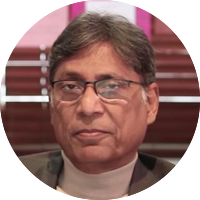Mohammad
Muhammad, the last prophet and founder of Islam, was born in Mecca (c. 570) in the tribe of Quraish. His father, Abdullah, had already passed away before he was born and his mother, Amena, died when he was only six years old. He was looked after by his paternal grandfather, Abdul Muttalib, who too left this world when he was only eight. He was then taken care of by his uncle Abu Talib. Since his mother was no more when he was still a child, he was fed by a wet nurse called Haleema. At the age of twenty five, he was married to Khadija, a prosperous widow aged forty who run a business and whom Mohammad had joined earlier to sell her merchandise.
When Mohammad reached the mature age of forty, he experienced the vision of Archangel Jibreel (Gabriel) when he was meditating in the cave of a mount known as Jabl-e Noor in Mecca. Jibreel revealed the first words of God upon him: “Recite in the name of your Lord who creates, creates a man from a clot of blood”. The process of revelation continued throughout his life. Compiled together, they constituted the content of Quran, the essential scripture of Islamic faith.
When Mohammad started his preaching in Mecca, he faced stiff opposition at the hands of those who worshipped idols and believed in polytheism. When hostility from his opponents reached its peak, he migrated from Mecca to Medina with his followers to avert an impending civil war in Mecca. He left Mecca in 622 with a mission to spread the word of God. This year was known as the year of hijrat (migration) and it also marked the beginning of Islamic calendar. In Medina, the number of his followers increased. However, a series of battles followed too. Finally, Mohammad gathered enough strength to prevail upon his foes. Thereafter, he set out for Mecca along with his followers to take control over the city and proclaim the faith he ardently propagated. On reaching Mecca, he ensured that minimum casualties take place. He also offered amnesty and pardoned many of his staunch opponents. Mecca soon became a city of Islamic followers who believed in one God and Mahammad as His messenger. In March 632, he delivered his last sermon from the mount of Arafat and asked his followers present there to reach his message to those who were not present there. He breathed his last in Medina on the 8th of June, 632. He was buried in the precincts of the mosque, now known as Masjid-e-Mabawi where he used to lead prayers.
Reference: Kyun na firdaus mein jaai Mayil/Jab Mohammad ka tawassul thehre (Ahmad Hussain Mayil) Also see: https://www.rekhta.org/ebooks/madah-e-rasool-raghib-muradabadi-https://www.rekhta.org/ebooks/naat-hi-naat-part-001-mohammad-masood-khan-ebooks
Muhammad, the last prophet and founder of Islam, was born in Mecca (c. 570) in the tribe of Quraish. His father, Abdullah, had already passed away before he was born and his mother, Amena, died when he was only six years old. He was looked after by his paternal grandfather, Abdul Muttalib, who too left this world when he was only eight. He was then taken care of by his uncle Abu Talib. Since his mother was no more when he was still a child, he was fed by a wet nurse called Haleema. At the age of twenty five, he was married to Khadija, a prosperous widow aged forty who run a business and whom Mohammad had joined earlier to sell her merchandise.
When Mohammad reached the mature age of forty, he experienced the vision of Archangel Jibreel (Gabriel) when he was meditating in the cave of a mount known as Jabl-e Noor in Mecca. Jibreel revealed the first words of God upon him: “Recite in the name of your Lord who creates, creates a man from a clot of blood”. The process of revelation continued throughout his life. Compiled together, they constituted the content of Quran, the essential scripture of Islamic faith.
When Mohammad started his preaching in Mecca, he faced stiff opposition at the hands of those who worshipped idols and believed in polytheism. When hostility from his opponents reached its peak, he migrated from Mecca to Medina with his followers to avert an impending civil war in Mecca. He left Mecca in 622 with a mission to spread the word of God. This year was known as the year of hijrat (migration) and it also marked the beginning of Islamic calendar. In Medina, the number of his followers increased. However, a series of battles followed too. Finally, Mohammad gathered enough strength to prevail upon his foes. Thereafter, he set out for Mecca along with his followers to take control over the city and proclaim the faith he ardently propagated. On reaching Mecca, he ensured that minimum casualties take place. He also offered amnesty and pardoned many of his staunch opponents. Mecca soon became a city of Islamic followers who believed in one God and Mahammad as His messenger. In March 632, he delivered his last sermon from the mount of Arafat and asked his followers present there to reach his message to those who were not present there. He breathed his last in Medina on the 8th of June, 632. He was buried in the precincts of the mosque, now known as Masjid-e-Mabawi where he used to lead prayers.
Reference: Kyun na firdaus mein jaai Mayil/Jab Mohammad ka tawassul thehre (Ahmad Hussain Mayil) Also see: https://www.rekhta.org/ebooks/madah-e-rasool-raghib-muradabadi-https://www.rekhta.org/ebooks/naat-hi-naat-part-001-mohammad-masood-khan-ebooks
Additional information available
Click on the INTERESTING button to view additional information associated with this sher.
About this sher
rare Unpublished content
This ghazal contains ashaar not published in the public domain. These are marked by a red line on the left.

